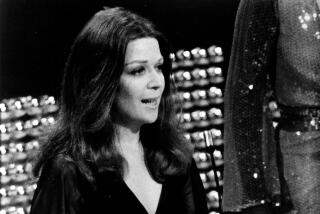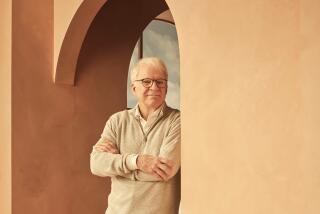Father of ‘The Waltons’ Set Standard for Family TV
- Share via
When writer-producer Earl Hamner asks me if I ever saw the TV classic “The Waltons,” I assure him, “Yes, I grew up in America.”
The model for all the wholesome family dramas that came after it, “The Waltons” was a hit for most of its almost 10 years on CBS. Based on Hamner’s own life as a young would-be writer and the oldest son of a Depression-era clan in the Blue Ridge Mountains of Virginia, “The Waltons” became part of American mythology.
Was there a household in the nation, during the 1970s, in which families did not jokingly recite: “Goodnight, John Boy,” “Goodnight, Jim-Bob” and so on, poking amiable fun at the way the Waltons ended their gentle, fruitful days?
Hamner wrote the autobiographical novel, “Spencer’s Mountain,” on which the show was based, produced the show and did the voice-over that opened and closed each episode. He had not yet published the book when he moved from New York City to Los Angeles. Here, he and wife, Jane, fell in love at first sight with a house in the hills of Studio City.
In a recently published memoir, Hamner recalls how he and Jane peered through the windows of the house on Avocado Drive and tumbled for its fireplace, high ceilings and panoramic view of the Valley. There seemed to be droves of children on the street who might be prospective friends for their young son, Scott, and his little sister, Caroline. The neighborhood and the house exuded a sense of community and stability, important to a man from Schuyler, Va.
Even after the success of “The Waltons,” the prime-time soap “Falcon Crest” and other Hollywood projects, Hamner saw no reason to transplant his family to a more pretentious house across the hill. Like other longtime Valleyites, he cannot quite plumb the mind-set that deifies the Westside and demonizes the canyon neighborhoods and other lovely areas of the Valley.
“I once hired a writer on ‘The Waltons,’ and she asked where I lived,” he says. After he told her, he recalls, “She said, in the nastiest voice, ‘I always wondered who lived in the Valley.’ And I never hired her again.”
Unlike so many contemporary memoirs, Hamner’s new “The Avocado Drive Zoo” lacks such now-all-but-standard elements as incest and a confession of drug or alcohol abuse. The only adulterous relationships are between unaltered dogs. And the only violence is the author’s smashing a spider between the pages of the book he is reading in bed when the large arachnid joins him uninvited. That’s something Hamner feels rather bad about in light of his writing the screenplay for Hanna-Barbera’s animated “Charlotte’s Web.”
*
As the title implies, the new book is about the menagerie the Hamners sheltered over the years. Their Studio City zoo included a 7-foot-long gopher snake that swam in the shallow end of their pool, a three-legged coyote and an alligator that caused a housekeeper to quit when she discovered it in the bathtub. Jane Hamner, her adoring husband says, “has a reverence for life akin to Albert Schweitzer’s.” She has even been known to make a case for rats.
Hamner, who often writes at night, says his first published work was a poem that appeared in the Richmond Times Dispatch when he was 6.
“I wrote a poem about my dog, and I didn’t have a dog. And I got one by writing about one, which must have been my impetus to become a writer.”
It’s a cliche, Hamner acknowledges, but the actors on “The Waltons” really did become a family, of sorts. Michael Learned, who played the mother, and Ralph Waite, the father, seemed to feel an almost parental responsibility for the youngsters in the cast.
“When the series was coming to an end, Michael and Ralph said, ‘I don’t think the children are ready for this to be over,’ ” Hamner recalls, and they consciously prepared the children for life after “The Waltons.”
Hamner had real affection for the cast. When Ellen Corby, who played Grandma, died earlier this year, Hamner didn’t take flowers to her funeral at Forest Lawn. “She always loved a good scene,” he recalls, and so he wrote her a final one. It was interred with her ashes.
Hamner knows that no business is more youth-oriented than TV. When he goes to pitch a series, Hamner jokes: “They are very nice, and they will receive me, and they offer me a chair or help me up the stairs.” But TV’s Gray List is as real as the Black List once was, and there are few deals made with people who drew their biggest audiences 20 years ago. Current practice notwithstanding, Hamner says, “some of us might have something akin to wisdom that might be worth celebrating.”
He’s recently finished a play, and he’s working on books on gardening, fishing and an elite group he calls “gracious women.”
*
Among the last, he plans to include Eleanor Roosevelt. Hamner recalls that he was once unavoidably late for a meeting with the former first lady. Instead of making him squirm, she assured him that his delayed arrival had given her time to write three letters in support of Adlai Stevenson’s bid for the presidency. Hamner, she implied, had done her a great favor.
Just as he once imagined the dog he longed for, Hamner imagined the perfect childhood for himself. “I always felt they had every right to sue me for invasion of privacy,” he says of the Hamners he fictionalized. (None ever did.)
Perhaps the greatest pleasure was finding the words that transformed his flawed real-life self into the hero of his best-loved show--the gifted and spirited John Boy.
“I was the best one,” he says, with a self-deprecating laugh, “John Perfect.”
More to Read
The complete guide to home viewing
Get Screen Gab for everything about the TV shows and streaming movies everyone’s talking about.
You may occasionally receive promotional content from the Los Angeles Times.






